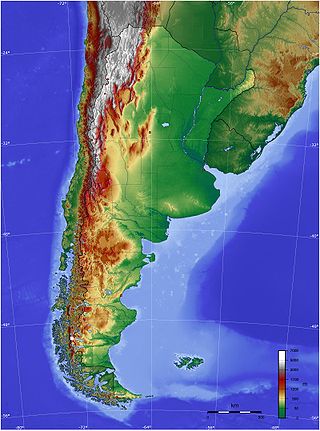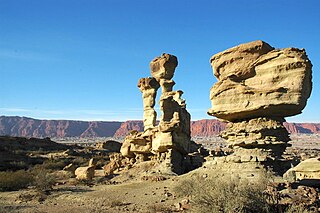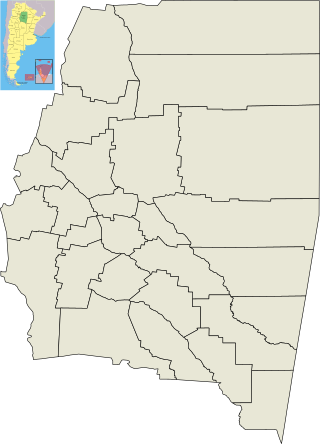
The geography of Argentina is heavily diverse, consisting of the Andes Mountains, pampas, and various rivers and lakes. Bordered by the Andes in the west and the South Atlantic Ocean to the east, its neighbouring countries are Chile to the west, Bolivia and Paraguay to the north, and Brazil and Uruguay to the northeast.

Buenos Aires, officially the Autonomous City of Buenos Aires, is the capital and primate city of Argentina. The city is located on the western shore of the Río de la Plata, on South America's southeastern coast. "Buenos aires" is Spanish for "fair winds" or "good airs". Buenos Aires is classified as an Alpha global city, according to the Globalization and World Cities Research Network (GaWC) 2020 ranking.

Formosa Province is a province in northeastern Argentina, part of the Gran Chaco Region. Formosa's northeast end touches Asunción, Paraguay, and the province borders the provinces of Chaco and Salta to its south and west, respectively. The capital is Formosa.

Argentina has a vast territory and a variety of climates and microclimates ranging from tundra and polar in the south to the tropical climate in the north, through a vast expanse of temperate climate. Natural wonders include the Aconcagua, the highest mountain in the world outside the Himalayas, the widest river and estuary of the planet, the Iguazú Falls, the Humid Pampas, and the Argentine Sea. Visitors enjoy the culture, customs and Argentine cuisine.

Neuquén is a province of Argentina, located in the west of the country, at the northern end of Patagonia. It borders Mendoza Province to the north, Rio Negro Province to the southeast, and Chile to the west. It also meets La Pampa Province at its northeast corner.

The Gran Chaco or Dry Chaco is a sparsely populated, hot and semiarid lowland tropical dry broadleaf forest natural region of the Río de la Plata basin, divided among eastern Bolivia, western Paraguay, northern Argentina, and a portion of the Brazilian states of Mato Grosso and Mato Grosso do Sul, where it is connected with the Pantanal region. This land is sometimes called the Chaco Plain.

The Bwindi Impenetrable National Park is a national park in southwestern Uganda. It is part of the Bwindi Impenetrable Forest and is situated along the Democratic Republic of the Congo border next to the Virunga National Park and on the edge of the Albertine Rift. Composed of 321 km2 (124 sq mi) of both montane and lowland forest, it is accessible only on foot. It is a United Nations Educational, Scientific and Cultural Organization-designated World Heritage Site.

The Bermejo River is a river in South America that flows from Bolivia to the Paraguay River in Argentina. The river is generally called Bermejo in spite of its different names along its way, but it also has its own Native American names; in Wichí it is called Teuco, and in Guaraní it is called Ypitá. In the plains of Argentina's Gran Chaco the Bermejo forms wetlands and splits into two branches. The southern branch is the bed of the old Bermejo River, now an intermittent stream called Río Bermejito. The northern branch is now the main stem of the Bermejo and is called the Teuco River, Bermejo Nuevo, or simply the Bermejo River. The two branches rejoin at 25°39′S60°11′W, near Villa Río Bermejito, forming the Lower Bermejo River.

The practice of sports in Argentina is varied due to the population's diverse European origins and the mostly mild climate. Association football is the most popular discipline and other sports played both professionally and recreatively athletics, auto racing, basketball, boxing, cycling, field hockey, fishing, golf, handball, mountaineering, mountain biking, padel tennis, polo, roller hockey, rowing, rugby union, sailing, skiing, swimming, tennis, and volleyball. Argentine achievements can be found in team sports such as association football, basketball, field hockey and rugby union, and individual sports such as boxing, golf, tennis and rowing. Pato, the national sport, is not very popular.

A provincial park is a park administered by one of the provinces of a country, as opposed to a national park. They are similar to state parks in other countries. They are typically open to the public for recreation. Their environment may be more or less strictly protected.

The Estadio Mario Alberto Kempes, formerly known as Estadio Córdoba, is a stadium in the Chateau Carreras neighborhood of Córdoba, Argentina. Owned by the Córdoba Province, the venue is used mostly for association football and rugby union matches and also sometimes for athletics.

Chivito is the national dish of Uruguay. It is a sandwich of sliced beefsteak (churrasco), mozzarella, ham, tomatoes, mayonnaise and black or green olives. A chivito commonly also includes bacon and fried or hard-boiled eggs. It is served in a bun, often accompanied by French-fried potatoes. Other ingredients, such as red beets, peas, grilled or pan-fried red peppers, and slices of cucumber, may be added.

El Calafate, also known as Calafate, is a city in Patagonia, Argentina. It is situated on the southern border of Lake Argentino, in the southwest part of the Santa Cruz Province, about 320 kilometres (200 mi) northwest of Río Gallegos. The name of the city is derived from a little bush with yellow flowers and dark blue berries that is very common in Patagonia: the calafate ; the word comes from the word calafate, which is Spanish for 'caulk'.

Monte Quemado is a municipality and village in Santiago del Estero in Argentina. It is the capital city of the Copo Department, Province of Santiago del Estero, Argentina, in the Chaco Austral region, practically in the El Impenetrable phytogeographic zone. It lies on national road RN 16, a route that runs parallel to a branch of the General Manuel Belgrano Railway and the aqueduct diverter from the Salado del Norte River known as the Canal de Dios. Precisely in Monte Quemado it starts as a branch of the aqueduct, the branch that goes to the south is called the Virgen del Carmen Canal, which runs parallel to provincial road RP 5 that connects Monte Quemado with Campo Gallo. Another land route which coincides with the RN 16 and RP 5 in Monte Quemado is provincial road RP 4.

Tomás Maria Cubelli is an Argentine professional rugby union player who plays as a scrum-half for Major League Rugby club Miami Sharks and the Argentina national team.

Club Deportivo Aguiluchos USA is an American soccer club, founded in 2012 and based in Oakland, California, that competes in the West Region, Golden Gate Conference of the National Premier Soccer League, the fourth division of the American soccer pyramid.

Claudia Alicia Bernazza is an Argentine teacher, social activist and politician who served as a National Deputy elected in Buenos Aires Province on two occasions: from 2007 to 2009, when she filled in the vacancy left by Graciela Rosso, and later from 2020 to 2021, filling the vacancy left by Daniel Scioli, who was appointed Ambassador in Brazil.

Normán Darío Martínez is an Argentine politician. A member of the Justicialist Party, Martínez served as a National Deputy representing Neuquén Province from 2016 to 2020, and later as Secretary of Energy in the Ministry of Economy, in the administration of minister Martín Guzmán, from 2020 to 2022.
Rewilding Argentina is an Argentine nonprofit conservation organization. It purchases private land, restoring ecosystems and developing wildlife corridors, then donates the land for national parks. The organization also reintroduces native species. Founded in 2010 by Argentine conservationists, Rewilding Argentina was preceded by Conservation Land Trust, which was established by Doug Tompkins in 1992.


















